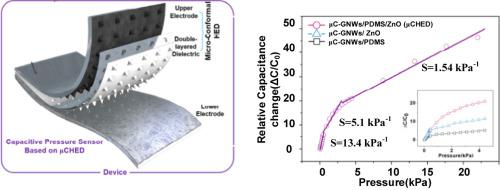Nano Energy ( IF 17.6 ) Pub Date : 2020-11-06 , DOI: 10.1016/j.nanoen.2020.105580 Shi Luo , Xi Zhou , Xinyue Tang , Jialu Li , Dacheng Wei , Guojun Tai , Zongyong Chen , Tingmao Liao , Jianting Fu , Dapeng Wei , Jun Yang

|
Flexible pressure sensors have attracted a lot of interest because of their widespread applications in healthcare, robotics, wearable smart devices, human-machine interfaces. While microstructuring both the electrodes and dielectrics has been proven to have a significant improvement in the sensitivity and response speed of piezocapacitive sensors, the synergetic influence of microstructured electrodes and dielectrics has not been discussed yet. Herein, a flexible piezocapacitive sensor has been demonstrated with a microstructured graphene nanowalls (GNWs) electrode and a conformally microstructured dielectric layer that consists of polydimethylsiloxane (PDMS) and piezoelectric enhancer of zinc oxide (ZnO). Such microstructured assembly with piezoelectric film constructs a microconformal GNWs/PDMS/ZnO electrode-dielectric integration (MEDI), which can effectively enhance the sensitivity and the pressure-response range. The piezocapacitive sensor exhibits an ultra-high sensitivity (22.3 kPa-1), fast response speed (25 ms), and broad pressure range (22 kPa). The finite element analysis indicates that the polarized electric field caused by the ZnO film’s piezoelectric effect greatly enhances the capacitance of the sensor. Moreover, the integration of the electrode and dielectric layer can eliminate the slippage between contiguous layers, which effectively increases the mechanical stability. Benefitting from the outstanding comprehensive performance, the potential application in robotic tactile perception has been successfully demonstrated, including object grabbing, braille recognition, and roughness detection. The MEDI in capacitive sensors provides a new approach to achieve high-performance E-skin, which delivers great potential applications in next-generation robotic tactile sensing.
中文翻译:

氧化锌微适形电极-电介质集成,用于灵活的超灵敏机器人触觉传感
柔性压力传感器由于在医疗保健,机器人技术,可穿戴智能设备,人机界面中的广泛应用而引起了人们的极大兴趣。虽然已经证明,电极和电介质的微结构化在压电电容传感器的灵敏度和响应速度方面有显着改善,但尚未讨论微结构化电极和电介质的协同影响。在本文中,已经证明了具有微结构化石墨烯纳米壁(GNW)电极和由聚二甲基硅氧烷(PDMS)和氧化锌压电增强剂组成的共形微结构介电层的柔性压电电容传感器。这种带有压电膜的微结构组件构成了微保形的GNW / PDMS / ZnO电极-电介质集成(MEDI),可以有效地提高灵敏度和压力响应范围。压电电容传感器具有超高灵敏度(22.3 kPa-1),快速响应速度(25 ms)和宽压力范围(22 kPa)。有限元分析表明,由ZnO膜的压电效应引起的极化电场大大增强了传感器的电容。此外,电极和介电层的集成可以消除连续层之间的滑动,从而有效地提高了机械稳定性。得益于出色的综合性能,已成功展示了在机器人触觉感知中的潜在应用,包括物体抓取,盲文识别和粗糙度检测。电容式传感器中的MEDI提供了一种实现高性能E皮肤的新方法,该方法在下一代机器人触觉感测中具有巨大的潜在应用。



























 京公网安备 11010802027423号
京公网安备 11010802027423号